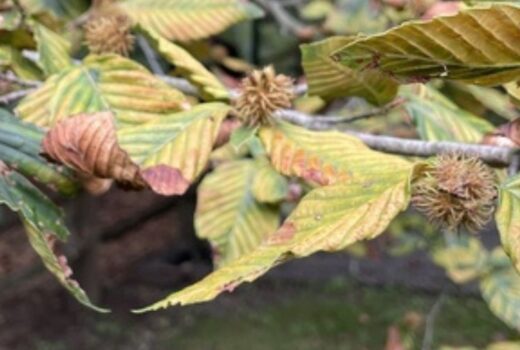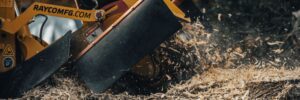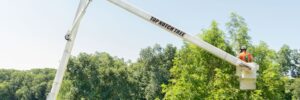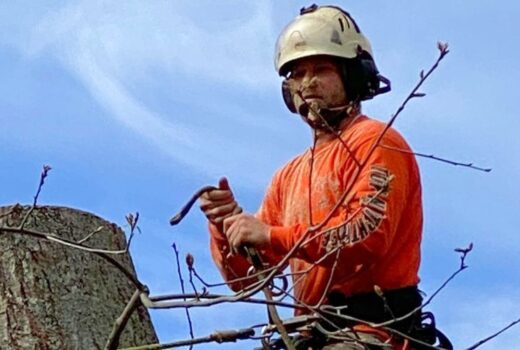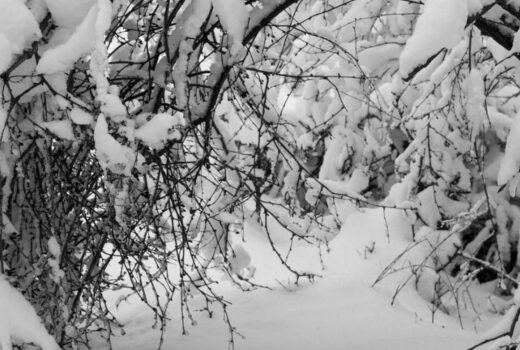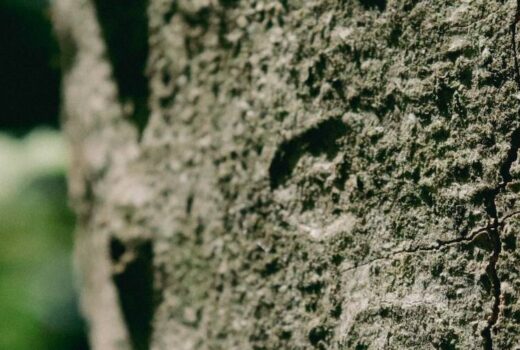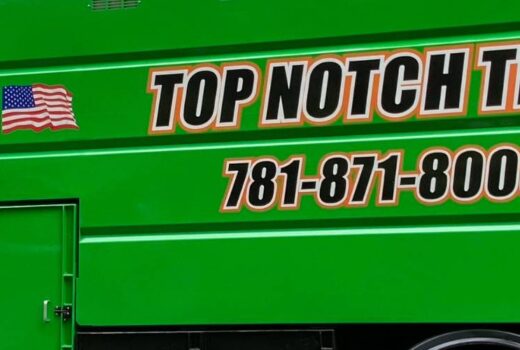As a homeowner on the Massachusetts South Shore, it is crucial to understand the importance of tree risk assessments. These assessments evaluate the health and stability of your trees, identifying any potential hazards that may threaten your property or safety.
By regularly conducting tree risk assessments, you can proactively manage at-risk trees and ensure the well-being of your home and loved ones.
Don’t overlook this critical step in maintaining a safe and secure environment.
Key Takeaways
- Regular tree risk assessments help identify and address issues with tree health and structure early on.
- Early intervention in identifying decaying sapwood, root damage, and structural issues prevents further damage and potential hazards.
- Regular tree assessments are critical for property safety, aesthetics, and cost savings.
- Taking necessary steps to prevent accidents or damage, maintaining tree health and beauty, and being proactive and responsible are key aspects of regular tree assessments for homeowners.
What is a Tree Risk Assessment?
A tree risk assessment is an evaluation that homeowners can use to determine the potential dangers and hazards associated with their trees. It is crucial for every homeowner to understand the importance of conducting a tree risk assessment to ensure the safety of their property and loved ones.
By conducting a tree risk assessment, you can identify trees that may pose a risk of falling or causing damage during storms or high winds. This assessment involves a qualified arborist inspecting the tree’s overall health, stability, and structural integrity. They will look for signs of disease, decay, weak branches, or any other factors that could increase the likelihood of tree failure.
Not only can a falling tree cause significant property damage, but it can also pose a serious threat to the safety of you and your family. Tree risk assessments help you identify potential hazards before they become emergencies, allowing you to take proactive measures such as seasonal pruning, cabling, or even removing hazardous trees.
A tree risk assessment can also help you determine the overall health of your trees and identify any necessary maintenance or treatment. Regular assessments can prevent the spread of diseases, improve tree health, and extend their lifespan.
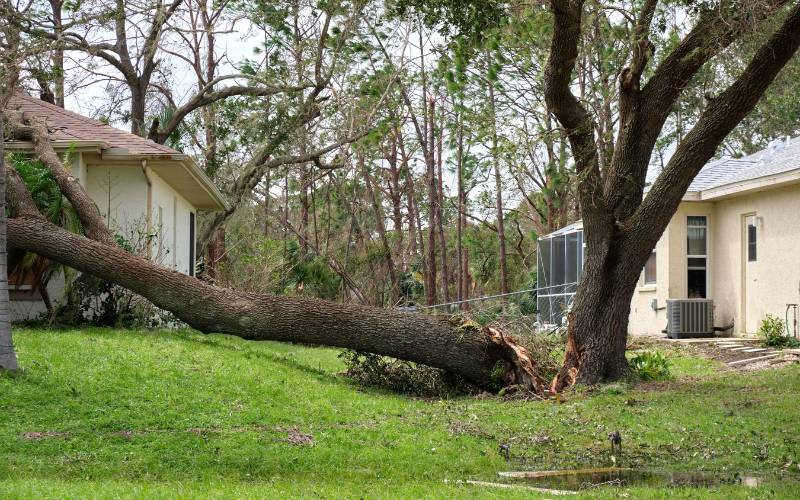
A tree risk assessment is the first step in keeping your trees safe.
Tree Risk Categories
Tree risk isn’t a simple “yes or no” scenario. Depending on the tree and what its issue could be, we place trees into four different risk categories:
Improbable: Sturdy trees that will likely survive storms. These trees show no indication of potential trunk failure or branch drop.
Possible: Trees are not likely to fall under normal conditions. However, extreme weather conditions, high winds, or heavy snowfall could compromise the tree’s safety and integrity.
Probable: Trees are likely to fall. These trees are showing signs of potential failure, including cracks, cracked branches, decay, pest infestation, and illness.
Imminent: Trees ready to fall immediately. These trees could fall at any time and show severe signs of illness, decay, cracked or hollow trunks, and broken branches.
By knowing which risk category a tree falls into, you can take appropriate measures to ensure the safety of your home and surroundings. In the case of probable and imminent at-risk trees, swift action should be taken to avoid tree failure and the damage it can cause.
Signs of At-Risk Trees
These indicators can be a clear indication that a tree is in danger and may pose a risk to your property.
By recognizing these signs early on, you can take necessary precautions to ensure the safety of your home and surroundings. This section will cover the following signs of tree risks:
- Trunk Cracks
- Abnormal Bark
- Missing Bark
- Decaying Sapwood
- Large Holes
- Root Damage
- Leaning
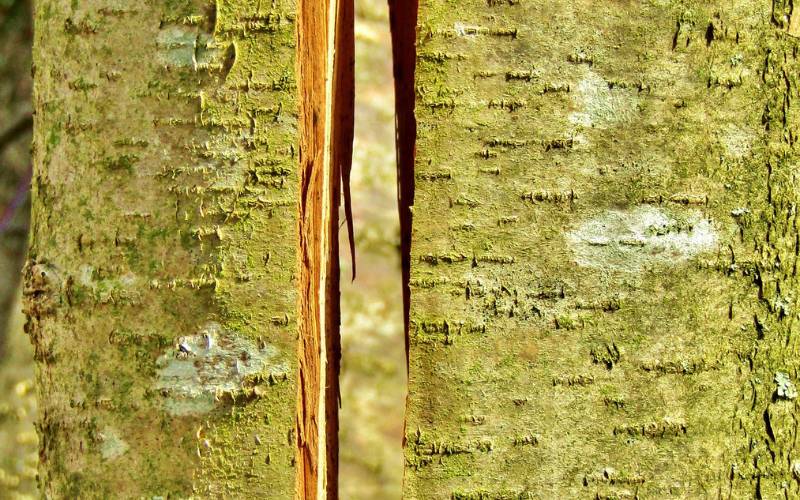
Trunk cracks are an indication that your tree could be at risk.
1. Trunk Cracks
Inspect your tree regularly for trunk cracks to ensure the safety of your home and property. Trunk cracks are a common sign of an at-risk tree and should not be ignored. These cracks can weaken the tree’s structure, making it more susceptible to falling during storms or high winds.
To properly assess trunk cracks, follow these steps:
- Look for visible cracks on the trunk, especially near the base.
- Check for signs of decay or discoloration around the cracked area.
- Measure the length and width of the crack to determine its severity.
- Consult with a certified arborist to evaluate the potential risks associated with the crack.
- Consider implementing necessary tree care measures, such as tree pruning or cabling, to mitigate the risk of tree failure.
Remember, addressing trunk cracks promptly can help prevent property damage and injuries caused by falling trees.
2. Abnormal Bark
Abnormal bark can be a sign of potential issues with your tree’s health and stability. It’s important for homeowners to understand what to look for when assessing the condition of their trees.
Abnormal bark can include peeling, cracking, or discoloration. If you notice any of these signs, it may indicate underlying problems such as disease, insect infestation, or physical damage.
Peeling bark, for example, could be a result of sunburn or frost damage. Cracks in the bark might indicate internal decay or structural weakness. Discoloration could be a sign of a fungal infection or nutrient deficiency.
By regularly inspecting your tree’s bark and identifying any abnormalities, you can catch potential issues early on and take necessary actions to protect your tree and your property.
3. Missing Bark
You may notice that bark is missing from your tree, which could be a sign of potential issues with its health and stability. Missing bark can occur due to various reasons, such as animal damage, fungal infections, or even human activities like accidental damage from lawnmowers or vehicles.
Regardless of the cause, it is essential to address this issue promptly, as it can lead to further problems for your tree. The bark acts as a protective layer, shielding the tree from pests, diseases, and extreme weather conditions. Without this protective covering, the tree becomes vulnerable to infections, decay, and even structural damage.
Additionally, missing bark can indicate underlying issues with the tree’s vascular system, affecting its ability to transport nutrients and water. Therefore, it is crucial to consult a professional arborist to assess the tree’s risk and determine the appropriate course of action to ensure its health and safety.
4. Decaying Sapwood
Sapwood is the soft wood beneath the bark of a tree. Decaying sapwood can weaken the overall structure of a tree and make it more susceptible to pests and diseases. When the sapwood begins to decay, it compromises the tree’s stability by weakening the wood. This decay is often caused by fungal or bacterial infections that enter the tree through wounds or cracks in the bark. As the decay progresses, the wood’s strength diminishes, increasing the risk of branches or the entire tree falling.
In addition to compromising stability, decaying sapwood creates an ideal environment for pests, such as wood-boring insects, to infest the tree. These pests can further damage the tree and contribute to its decline.
5. Large Holes
Inspect your trees for large holes, as they can weaken the structure and attract pests. These holes can be caused by animals like woodpeckers or insects such as borers.
When trees have large holes, their structural integrity is compromised, making them more susceptible to breakage during storms or high winds. Additionally, these holes provide ideal entry points for pests to invade the tree, which can further weaken it and lead to its eventual demise.
It is crucial to regularly assess your trees for any signs of large holes and take appropriate action if necessary. This may involve consulting with a professional arborist who can provide guidance on how to mitigate the risks associated with large holes and preserve the health and safety of your trees.
6. Root Damage
Take note of any signs of root damage, such as exposed or damaged roots, as they can compromise the stability and health of your trees. Root damage is a serious concern that should not be overlooked.
Here are three reasons why it is important to address root damage promptly:
- Structural instability: Roots provide essential support to trees, anchoring them in the soil. When roots are damaged, the tree’s stability is compromised, increasing the risk of it toppling over during strong winds or storms.
- Nutrient and water uptake: Healthy roots are crucial for the absorption of nutrients and water from the soil. Damaged roots cannot effectively perform this function, leading to nutrient deficiencies and dehydration, which can weaken and eventually kill the tree.
- Disease susceptibility: Damaged roots are more susceptible to infection by pathogens and pests. Once a tree’s roots are compromised, it becomes vulnerable to various diseases that can spread throughout the entire tree, causing irreversible damage.
By addressing root damage promptly, you can protect the overall health and longevity of your trees.
7. Leaning
A leaning tree is not merely an aesthetic concern; it can be a silent messenger of potential danger.
Now, a little tilt isn’t unusual, often just nature’s way of responding to the wind or changes in the soil. But if your tree looks like it’s doing the limbo or has suddenly gone off-kilter, that’s when we need to pay attention. It could be hinting at issues like compacted soil, trouble with its roots, or even some lurking diseases that are affecting its stability.
The real worry kicks in when a leaning tree goes from quirky to potentially risky. Keep an eye out for sudden changes in its tilt, visible cracks or splits in the trunk, or signs of decay. And in Massachusetts, where we’re no strangers to intense weather, a leaning tree might be a sign of trouble ahead, especially after a nor’easter or heavy snow.
Timing matters when it comes to checking if your leaning tree is more than just a slouch. Regular check-ups by a certified arborist can catch potential problems before they become serious, preventing damage to your property or, more importantly, keeping everyone safe.
Managing At-Risk Trees
You should consider evaluating and addressing the management of trees that are at risk. Managing at-risk trees is crucial to ensure the safety and well-being of your property and loved ones. By taking proactive steps, you can prevent potential accidents and costly damages.
Regular maintenance is key to managing at-risk trees. Schedule routine inspections by a professional arborist to monitor the tree’s health and address any potential risks promptly. Keep in mind that prevention is always better than dealing with the consequences of a fallen or damaged tree.
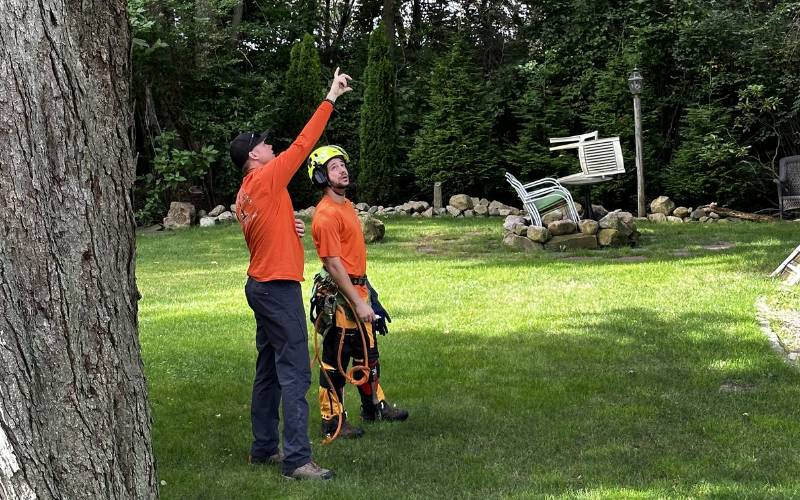
Professional tree services are your best bet to ensure your trees are safe.
Why You Should Get Regular Tree Assessments
Regular tree assessments are essential for ensuring the safety and health of your property and surroundings. By getting regular tree assessments, you can identify any potential risks or issues with your trees before they become a major problem. Trees that are not regularly assessed can pose a serious threat to your property and the people living in it.
During a tree assessment, a certified arborist will thoroughly inspect your trees for any signs of disease, decay, or structural issues. They will also assess the overall health and stability of the tree, checking for any signs of stress or weakness. By identifying these issues early on, you can take the necessary steps to address them and prevent any accidents or damage.
Regular tree assessments also play a crucial role in maintaining the aesthetics of your property. By identifying and addressing any issues with your trees, you can ensure that they remain healthy and vibrant, enhancing the overall beauty of your landscape.
In addition to ensuring the safety and aesthetics of your property, regular tree assessments can also help save you money in the long run. By addressing any issues early on, you can avoid costly tree removal or property damage caused by falling branches or uprooted trees.
Getting regular tree assessments is a proactive and responsible step to protect your property and the people living in it. By identifying any potential risks or issues with your trees, you can take the necessary steps to ensure their safety and health while also maintaining the beauty of your landscape.
Tree Risk Assessments – Frequently Asked Questions
Are tree risk assessments only necessary for homeowners with large, mature trees?
No, tree risk assessments are not only necessary for homeowners with large, mature trees. All homeowners should consider getting a tree risk assessment to ensure the safety of their property and prevent any potential damage or accidents.
Can tree risk assessments prevent all tree-related accidents and damage?
Tree risk assessments cannot prevent all tree-related accidents and damage, but they significantly reduce the risk. By identifying potential hazards, implementing preventive measures, and ensuring proper maintenance, tree risk assessments help keep you and your property safe.
How often should homeowners schedule tree risk assessments?
You should schedule tree risk assessments every 1-3 years to ensure the safety of your property. Regular assessments help identify potential risks and prevent accidents or damage caused by trees on your premises.
Are there any legal requirements for homeowners to conduct tree risk assessments
There are no legal requirements for homeowners to conduct tree risk assessments. However, it is highly recommended to ensure the safety of your property and avoid potential liability issues.
Can homeowners conduct tree risk assessments on their own, or is professional assistance always necessary?
Homeowners can conduct tree risk assessments on their own, but professional assistance is highly recommended. Trained arborists have the expertise to accurately assess risks and provide guidance to ensure the safety of both the homeowner and the property.
Need an Assessment of Your At-Risk Trees?
Call Top Notch Tree today at 781-871-8008. Our tree care experts have the skill and experience to assess your trees and help you determine the best course of action for keeping them safe and healthy, whether it’s pruning you need or a removal.
Trust us with your trees!
Proudly serving the Massachusetts South Shore, including Norfolk and Plymouth Counties.


